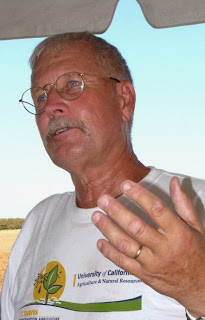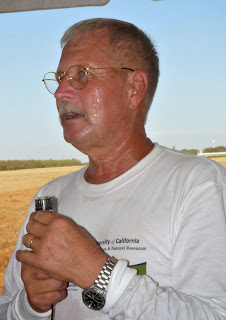
Conservation Tillage Research
Shows Benefits
By Patrick Cavanaugh, Editor
 |
| Twilight Conservation Tillage Attendees listen to speakers |
Jeff Mitchell, a UC Davis cropping systems specialist and the coordinator of the recent Twilight Conservation Tillage (CT) field day noted the ‘unifying themes’ that the UC and industry are working on. The event included three bus tour stops at three center pivot locations and several stops at the UC West Side Research and Education Center in Five Points.
“Our basic goal in this event was to provide new and emerging information on precision irrigation systems and in particular overhead irrigation which may be far more widely used in the Valley in the future,” said Mitchell.
“Second, we also intended to provide information and solutions, both technological and also in terms of soil management, to problems that may arise with the use of this new irrigation approach,” Mitchell said, adding, “These technologies include careful matching of water application devices (nozzle packages) and innovative ‘boom back’ drop hoses that keep wheel tracks dry.”
The soil management practices include reduced disturbance, residue preservation, and soil carbon building through the use of cover crops. Together, these strategies can improve soil quality and function and allow the sustainable use of cheaper, precision irrigation systems such as overhead.
 |
| Mitchell spoke about CT Research |
Our third theme was to provide new information on various applications of ‘conservation agriculture’ that we’ve been working on. These include no-till cotton and tomato production, strip-tillage sugar beet production in high residue, flat-planted conditions, and the use of cover crops in SJV annual cropping systems.
“A big part of what we talked about was conservation agriculture,” said Mitchell. “This cultural practice is used in different areas around the world as an alternative to conventional agriculture,” he said.
He outlined what a diverse group of UC researchers, farmers and others who are part of the Conservation Agriculture Systems Innovation (CASI). A lot of it points to what we have been doing with conservation agricultural principles and practices here.
“In the context of how to improve the soil resource, well it’s a hard case to make,” Mitchell said. “Why should anyone be concern with soil quality? Since data has been collected since 1920 with processing tomatoes, the yields have gone up 747 percent. This phenomenal success in increased production is indisputable. With this in mind, many could rightly ask how in the world could anyone say that I have a problem with soil quality,” noted Mitchell.
Mitchell outlined concerns stemming from a late April meeting with growers along with UC Farm Advisors, Natural Resources Conservation District (NRDC) and private companies. The goal of the meeting was to come up with a list of practices that people would recognize as improving the soil.
“The ideas on list were really nothing new,” said Mitchell. “But I would doubt that there are very many people doing some of the harder ones such as reducing soil disturbance, which means reducing physical, biological and chemical disturbance. Most fields are very heavily tilled.”
The list also stated that rotating crops would be good, and there are many growers who do that. But Mitchell said there are growers who are deliberately trying to increase soil carbon.
 |
| “Soil Improvement ideas are not new.” |
Soil carbon relates to the organic matter in the soil. It improves the physical properties of soil. It increases the cation exchange capacity (CEC) and water-holding capacity of sandy soil, and it contributes to the structural stability of clay soils by helping to bind particles into aggregates, which improves soils.
Mitchell said there are farmers around the country such as in Ohio and New Mexico, who are using no till, (reduced disturbance). “They are adding cover crops to their systems and increasing soil carbon and at the same time, they are reducing cost. So there are people who are doing this,” he said.
Mitchell then discussed the long-term CT work at the UC Westside Research and Education Center.
“In field trials here we had a standard till no cover crop during the winter, so it was pretty bare ground. Then we had a standard till where we worked the soils, reworked the beds with a cover crop during the winter,” Mitchell said.
Then he pointed out a CT area, which is no-till, with a residue of processing tomato vines. “We are going to plant cotton into the beds next spring—that’s zero tillage, and reduced disturbance.
Next to that field we have a CT area where we are going to plant a cover crop this fall to get more organic matter into the soil.
NRCS offices have some cost-share funding available for growers wanting to attempt conservation practices. They are finding that growers who use less tillage also have more carbon in the soil. And while growers are also saving money with less tillage passes, NRCS does not show us doing very well in the west.
Also there are some growers in the Midwest that are betting that high quality no-tilled soils around the country and the world are going to have increased value for production in the coming years. So some growers with venture capitalist behind them are buying up soils and encouraging growers to practice no-till farming to have a better resource. These investors are actually trying to make money on these soil improvement practices.
“Since 1998, we have tried to look at these kinds of CT systems, that reduce disturbance, and accumulates residue on the soil surface, noted Mitchell. “Are there benefits to this? Are there benefits in saving water, cycling nutrients due to the cover crop? Is there anything that can be tweaked to give us benefits such as lowering soil temps? Maybe microorganisms are able to thrive better during certain times of the year when the soil is not baking.” Mitchell noted
 |
| Mitchell: Soil Organic Matter Holds more Water |
“Conservation Ag is globally becoming recognized, as an alternative to the status quo,” he said. “It’s about incorporating and integrating ecological management with high tech and high productivity kinds of systems. It’s not to go backwards but instead to merge the best of many kinds of systems.”
“As you reduce tillage, there is more plant residue accumulating on the beds. A percentage of these residues will be there when you plant the next crop. A big part of the trials is controlled traffic. The no-tilled beds that have been growing cotton and tomato have not been moved in 12 years. There has not been any breaking up of beds. In some systems we add a cover crop to try and improve the soil if we have water this winter,” Mitchell noted.
But he pointed out something very interesting. He said that in the cover crop field over the last 14 years, he has added only eight inches of supplemental water to grow the cover crop. “After 12 years we have added essentially he small research field has had an additional 19 tons of organic material or seven tons of carbon than it wouldn’t have had in a bare condition, with just eight inches of water and normal rainfall.
“If you just do CT, our study has shown there is a carbon increase just by not disturbing the soil. And if you combine cover crops and CT you get the biggest carbon benefit,” noted Mitchell
One take home message is that if the soil is improved through CT methods or cover crops, then the infiltration rate can be increased if and when rain comes. It would be good to bank the water we get we may get instead of it ponding on the surface and evaporating.
The CT yield story is not so encouraging regarding tomato production. “In the early years the tomatoes on the CT system, for whatever reason did well,” said Mitchell. “But during he last several years, including this past year, yields have gone down. Some of the problems were due to diseases, but think we either have some rotation issues or we need to address our management there,” he added.
“However, for the last or six years we have had cotton yields in the no-till plots that matched the standard till plots.”
“However, for the last or six years we have had cotton yields in the no-till plots that matched the standard till plots.”








